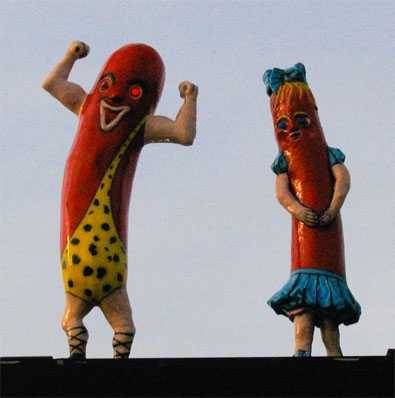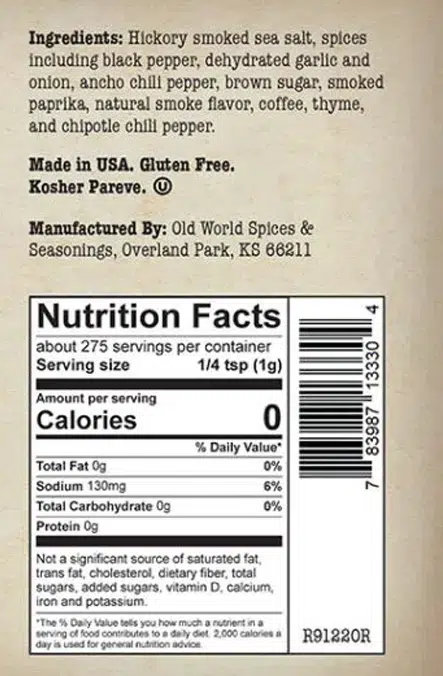Are they dangerous?

Before we get down to the details, let’s make the 800 pound gorilla comfortable.
In a review of franks in 2007, Consumer Reports (CR) said that the nutritionists they consulted concurred that “a sound diet can reasonably include any type of food, in moderation.” So there.
The Vienna Beef Frank is easily the most popular in Chicago. Here’s what’s in it:
Ingredients: Beef, water, salt, corn syrup, dextrose, mustard, natural flavorings and coloring, garlic juice, sodium erythorbate, sodium nitrite, extractives of paprika.
Size: 5 1/4 x 3/8″
Weight: 45 grams
Fat: 11 grams (4.5 grams saturated)
Protein: 6 grams
Carbohydrates: 1 grams
Sodium: 420 milligrams
Cholesterol: 25 milligrams
Calories: 130
As you can see, the canonical all beef Chicago Hot Dog by itself is not very caloric with 130 calories. There are more calories in the bun: 140 calories! The toppings add another 43 calories. With the bun and all the classic Chicago Hot Dog toppings, you get 313 calories and lots of sodium (salt).
OK, so they are not the healthiest food in the world. Many manufacturers now offer low fat, fat free, and low sodium franks. According to industry sources, these “better for you” franks now account for almost 15% of the total market. Problem is, CR found that many of the poultry and uncured franks contained almost as much or more fat, sodium, nitrites and nitrates as regular franks. In my tastings and in CR’s tastings, they didn’t score as well as the full-fat all beef franks.
What’s in them?
You can make a sausage from just about anything. There are chicken sausages, vegan sausages, and fish sausages. But they are not frankfurters. Franks are finely ground into a slurry, and are all beef or mostly beef. Some have pork and veal in the blend, and there’s even a place on the coast of Connecticut that makes lobster hot dogs, but these are not true franks.
The typical beef frankfurter is made from cheeks, jowls, and bull meat, as well as cuts too tough to serve straight, trimmings from the butchering process, someimes with corned beef and pastrami trimmings for flavor. They are seasoned with a secret mix of spices, and nitrites are added as preservatives (more on nitrites and nitrates later). Without much effort one can find hot dogs made from pork, turkey, chicken, and even, gawd forbid, soybeans.
According to the USDA, the finished products must contain at least 15% muscle meat and meat byproduct and may not contain more than 30% fat, 10% water, 3.5% dry milk or cereal as a binder, and 2% isolated soy protein. They may contain pig snout, lips, heart, kidney, liver, and stomach, but these must be individually named in the ingredients statement on the label. Contrary to what you might have heard, crushed bones, eyeballs, and testicles are not allowed.
Some brands contain only beef, water, spices, and sodium nitrite. On the labels of the many brands I have tasted I have also found salt, garlic, paprika, mustard, onion powder, corn syrup, dextrose, corn gluten, wheat gluten, nutmeg, coriander, white pepper, raw sugar, sodium lactate, celery juice, honey, dried honey, protein, partially hydrolyzed beef stock, potato starch, nonfat dry milk, hickory smoke flavor, sorbitol, sodium lactate, hydrolyzed soy, sodium diacetate, sodium phosphate, sodium erythorbate, autolyzed yeast extract, and caramel color, and ascoribic acid (vitamin C).
How are they made?
The meat is gathered and coarsely ground, then ground again. During the grinding, the spices, curing ingredients, and water, often in the form of ice cubes are added. The ice helps keep the meat cool during the grinding. The output is then a thick emulsion sometimes called “batter”.
The batter goes into the casing machine. Casings are made from animal intestines or cellulose. Lamb is about the right size for hot dogs, so they are common for natural casing specimens. By far the majority go into cellulose, which is usually removed later to make the popular skinless dogs. Casings are scrunched up on the nozzle of the machine, and as the meat is pumped through it forms a loooonnnng sausage. These tubes are then twisted into linked links of whatever size the producer wants. Some factories still do this by hand, but most are done by machine. They are then draped on racks.
Then it is off to the smokehouse, a huge stainless steel walk-in where they are heated and pre-cooked and bathed in hardwood smoke and humidity. They come out and are rinsed, and if they are to be sold skinless they are fed into s slitting machine where a blade slits the cellulose casing and it is removed. The finished skinless franks are shot from the machine like bullets!
Finally they go to the packaging station where they are inspected, packed, labeled, and boxed for storage in the cold room, and eventually shipment to stores and restaurants.
About nitrites and nitrates in hot dogs
Practically every hot dog has had sodium nitrite added. It is also common in other cured meats such as bacon, ham, some luncheon meats, some sausages, and occasionally in poultry and fish. Nitrite is added because it inhibits the growth of Clostridium botulinum, the cause of botulism.
Sodium nitrite also gives cured meats their characteristic reddish-pink color and adds to their taste and texture. Nitrites also expand when cooked, helping the pups plump when hot. A few companies make hot dogs without nitrites, but most do not taste very good. Only one, Hans’ All Natural Uncured Beef Hot Dogs, ranked “Highly Recommended” in my tastings.
In the 1970s early research indicated that sodium nitrite could cause cancer in laboratory animals. It got a lot of publicity and as a result some people began calling hot dogs “death dogs.” Since then more thorough research by scientists around the world on the safety of nitrites has contradicted these early experiments. Over the past 30 years the meat industry has significantly reduced the amount of nitrates and nitrites added to meats and the amounts actually used are typically way below the allowable amount. In other words, Americans would have to eat a lot of hot dogs every day to exceed the amount deemed safe. Clcik here for more info on the subject of nitrites and nitrates.






High quality websites are expensive to run. If you help us, we’ll pay you back bigtime with an ad-free experience and a lot of freebies!
Millions come to AmazingRibs.com every month for high quality tested recipes, tips on technique, science, mythbusting, product reviews, and inspiration. But it is expensive to run a website with more than 2,000 pages and we don’t have a big corporate partner to subsidize us.
Our most important source of sustenance is people who join our Pitmaster Club. But please don’t think of it as a donation. Members get MANY great benefits. We block all third-party ads, we give members free ebooks, magazines, interviews, webinars, more recipes, a monthly sweepstakes with prizes worth up to $2,000, discounts on products, and best of all a community of like-minded cooks free of flame wars. Click below to see all the benefits, take a free 30 day trial, and help keep this site alive.
Post comments and questions below
1) Please try the search box at the top of every page before you ask for help.
2) Try to post your question to the appropriate page.
3) Tell us everything we need to know to help such as the type of cooker and thermometer. Dial thermometers are often off by as much as 50°F so if you are not using a good digital thermometer we probably can’t help you with time and temp questions. Please read this article about thermometers.
4) If you are a member of the Pitmaster Club, your comments login is probably different.
5) Posts with links in them may not appear immediately.
Moderators